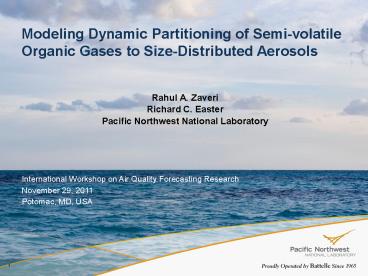Modeling Dynamic Partitioning of Semi-volatile Organic Gases to Size-Distributed Aerosols - PowerPoint PPT Presentation
1 / 21
Title:
Modeling Dynamic Partitioning of Semi-volatile Organic Gases to Size-Distributed Aerosols
Description:
Modeling Dynamic Partitioning of Semi-volatile Organic Gases to Size-Distributed Aerosols Rahul A. Zaveri Richard C. Easter Pacific Northwest National Laboratory – PowerPoint PPT presentation
Number of Views:104
Avg rating:3.0/5.0
Title: Modeling Dynamic Partitioning of Semi-volatile Organic Gases to Size-Distributed Aerosols
1
Modeling Dynamic Partitioning of Semi-volatile
Organic Gases to Size-Distributed Aerosols
- Rahul A. Zaveri
- Richard C. Easter
- Pacific Northwest National Laboratory
International Workshop on Air Quality Forecasting
Research November 29, 2011 Potomac, MD, USA
2
Outline
- Motivation
- SOA formation processes
- SOA modeling challenges
- MOSAIC aerosol modeling framework
- Gas-particle partitioning of organic gases (new)
- Sample results
- Future Directions
3
Need to efficiently and reliably model aerosol
size, number, mass, composition, and their
climate related properties at urban to global
scales
Battelle Proprietary
4
SOA Formation Processes
- Up to 90 of submicron aerosol mass is composed
of organics (Kanakidou et al., 2005 Zhang et
al., 2007) - SOA formation is quite rapid (within a few hours)
during daytime (Volkamer et al., 2006 Kleinman
et al., 2007 de Gouw et al., 2008) - SOA from oxidation of SVOCs from diesel exhaust
may help explain some of the missing organic
aerosol mass in models (Robinson et al., 2007) - Observed rapid growth of newly formed particles
(via homogeneous nucleation) is thought to be by
SOA condensation (Kuang et al., 2008) - Anthropogenic and biogenic SOA precursors may
interact to enhance the overall SOA yield (Weber
et al., 2007) - Particle-phase reactions of absorbed VOCs within
inorganic particles can form SOA (Jang et al.,
2003 Kroll et al., 2005 Liggio et al., 2005) - Accretion reactions, including aldol
condensation, acid dehydration, and gem-diol
condensation can transform VOCs into oligomeric
compounds (Gao et al., 2004 Jang et al., 2003
Kalberer et al., 2004)
5
SOA Modeling Challenges
- Gas-particle partitioning processes are still
poorly understood at a fundamental level - How do we handle the complexities in the
gas-phase VOC chemistry? - Should we use Raoults Law or some sort of
reactive uptake formulation as driving force for
gas-particle mass transfer? - Should we use Henrys Law if the organics are
dissolved in the aqueous phase? - Are the organic particles liquid or solid?
Virtanen et al. (2011) and Vaden et al. (2011)
suggest that SOA particles are solid. - How do we treat organic-inorganic interactions
and the associated phase transitions? - How do we treat particle-phase reactions? What
are the time scales? - What are the anthropogenic-biogenic interactions?
How do we reliably represent them in models?
6
General Problem Solving Approach
- Develop a comprehensive aerosol model framework
that includes all the processes that we think are
(or might be) important - Evaluate the roles of specific processes using
appropriate laboratory and field observations - Simplify, parameterize, and optimize the process
model as much as possible to increase
computational efficiency and decrease memory
requirements
7
MOSAIC Aerosol Module
- Model for Simulating Aerosol Interactions and
Chemistry (Zaveri et al., 2008) - Comprehensive aerosol module for air quality and
climate modeling - Flexible framework for coupling various gas and
aerosol processes - Robust, accurate, and highly efficient custom
numerical solvers for several processes - Suitable for 3-D regional and global models
- Implementation in
- Weather Research and Forecasting Model (WRF-Chem)
done - Global model Community Atmosphere Model (CAM5)
in progress - EPAs CMAQ planned
8
Thermodynamics Mass Transfer Treatments in
MOSAIC
Kinetic mass transfer between the gas and
size-distributed particles (1 to 10,000 nm)
Thermodynamic equilibriumwithin the particle
phase (depends on composition and RH)
- Custom numerical techniques have been developed
to solve these equations efficiently and
accurately
9
Gas-Particle Partitioning of Organics
- Organic-inorganic interactions within the
particle to determine water uptake and phase
separation(partially implemented) - Size-distributed, dynamic mass transfer between
gas and particles - Raoults Law in the absence ofaqueous phase
(implemented) - Reactive uptake that instantly converts VOC to
non-volatile products (implemented) - Henrys Law in the presence of aqueous phase
(future) - Particle-phase reactions (future)
10
Raoults Law vs. Reactive Uptake
Raoults Law Based Mass Transfer
HC oxidant ? a1 G1 a2 G2
A1 A2
xi mole fraction
dGi dt
-ki (Gi xiPi0)
vapor pressure
11
Sample Results
- Idealized Case
- Sacramento Urban Air Case
12
Idealized Case
Initial aerosol composition mass ratio
OA/(NH4)2SO4 1
13
Idealized Case
Initial aerosol composition mass ratio
OA/(NH4)2SO4 1
14
Idealized Case
Initial aerosol composition mass ratio
OA/(NH4)2SO4 1
15
Sacramento June 6, 2010
Initial aerosol composition mass ratio
OA/(NH4)2SO4 10
16
Sacramento June 6, 2010
Initial aerosol composition mass ratio
OA/(NH4)2SO4 10
17
Sacramento June 6, 2010
Initial aerosol composition mass ratio
OA/(NH4)2SO4 10
18
Sacramento June 6, 2010
Aitken mode mass ratio OA/(NH4)2SO4 10
Accumulation mode mass ratio OA/(NH4)2SO4 0.01
19
Sacramento June 6, 2010
Aitken mode mass ratio OA/(NH4)2SO4 10
Accumulation mode mass ratio OA/(NH4)2SO4 0.01
20
Future Directions
- Perform additional constrained Lagrangian model
analyses to test different SOA formation
mechanisms - Use carefully designed chamber experiments to
constrain and evaluate different formulations - Extend model analyses to mixtures of organic and
inorganic species at different relative
humidities - Implement and evaluate new SOA formulations in
WRF-Chem using urban to regional field
observations
21
Thank you for your attention
Funding for this work was provided by Department
of Energy (DOE) Atmospheric System Research (ASR)
Program

